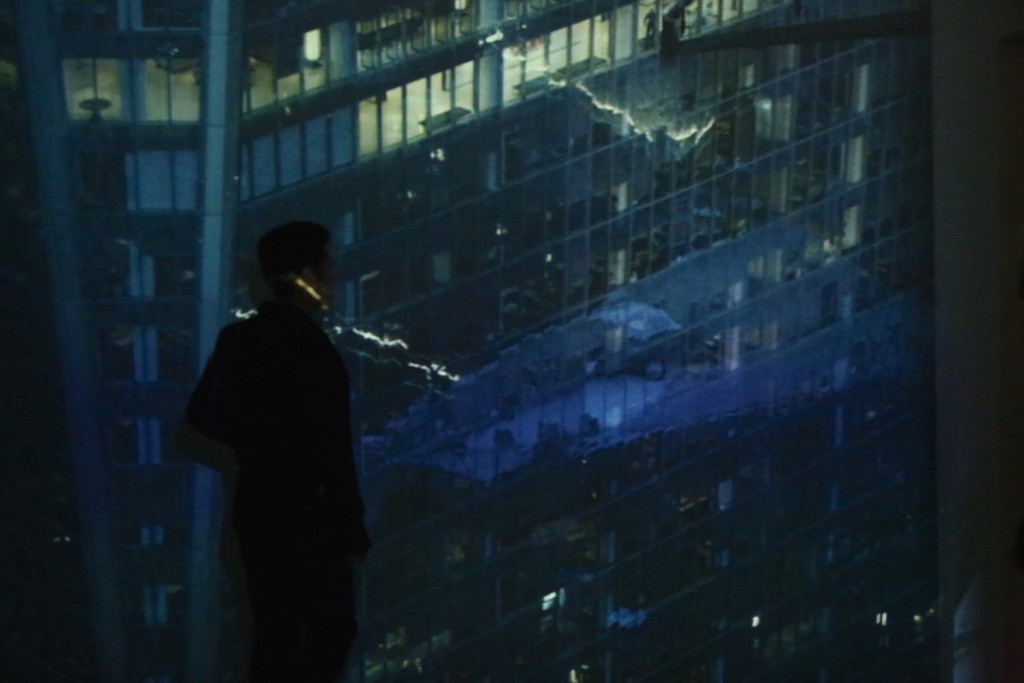
Jesper Just, “in the shadow/ of a spectacle/ is the view of the crowd” (2015) a commission of Performa 15. The performance was held at 225 Liberty Street, NY, Photograph by Paula Court, courtesy of Performa.
From November 13th through 15th, 2015, artist Jesper Just in collaboration with FOS presented in the shadow/ of a spectacle/ is the view of the crowd (2015) a commission of Performa 15. The performance was held at 225 Liberty Street, now known as the Time Inc. building, in the heart of what since 2001 has been called Ground Zero. The structure stands in the shadow of One World Trade Center, which can be viewed from the east and northeast facing windows. On the west side of the building is the Hudson River with New Jersey rising in the distance and a perfect vantage point for epic sunsets. While much of the publishing industry (Conde Nast rents many of the floors in One World Trade) and Wall Streeters’ frequent this area on a daily basis, it doesn’t have much traction for those interested in contemporary art. That being said, having a performance in such a loaded arena is not an easy task. Many New Yorker’s, have yet to venture to see the 9/11 memorial or One World Trade Center for that matter, close-up. Yet, at 104 stories, the building can be seen from many of the boroughs that surround Manhattan island. That being said, if anything is going to emit a gravitational pull transporting me towards this site, it’s art and this was particularly specific.
On the eve of the performance, I found myself on a mission, not only to see Just and his FOS collaboration, but also the reflecting pools honoring 9/11. Walking towards the westside my stomach churned. Americans and specifically New Yorker’s will always remember where they were the day the World Trade Center Towers fell (side note* I was in a small town in Tuscany on an artist residency). The project titled Reflecting Absence, designed by architect Michael Arad and landscape architect Peter Walker, was completely realized in 2011 and consists of two reflecting pools and the largest artificial waterfalls in the country filling the circumference of where the Twin Towers once stood. Surprisingly (or not surprisingly) the effect is chilling. The sound of the water rushing is evident, yet due to the depth of the pools and waterfalls that extend below street level and towards what looks like the center of the earth, its impossible to see a definite ‘bottom’. In a city where people build upwards and every inch of land is considered valuable, the vast ’emptiness’ of the pools honors the victims not only with sound and silence but also with expansive space and maybe that is the greatest gift of all.
>>>>>>>>>>>>>>>>>>>>>>>>>>>>>>>>>
Jesper Just was born in Copenhagen and has lived in New York for ten years. He shows with James Cohan Gallery in New York and Galerie Perrotin in Paris and Hong Kong. FOS (Thomas Poulsen), a frequent collaborator of Just’s, is also from Copenhagen. Their performance was a visual notation on the act of spectatorship, lasting one hour, combining both audio intervention with visual —both live and recorded— documentation. Taking place over three nights in late November, visitors to in the shadow/ of a spectacle/ is the view of the crowd, were escorted to the 45th floor of 225 Liberty and deposited outside of the elevators.
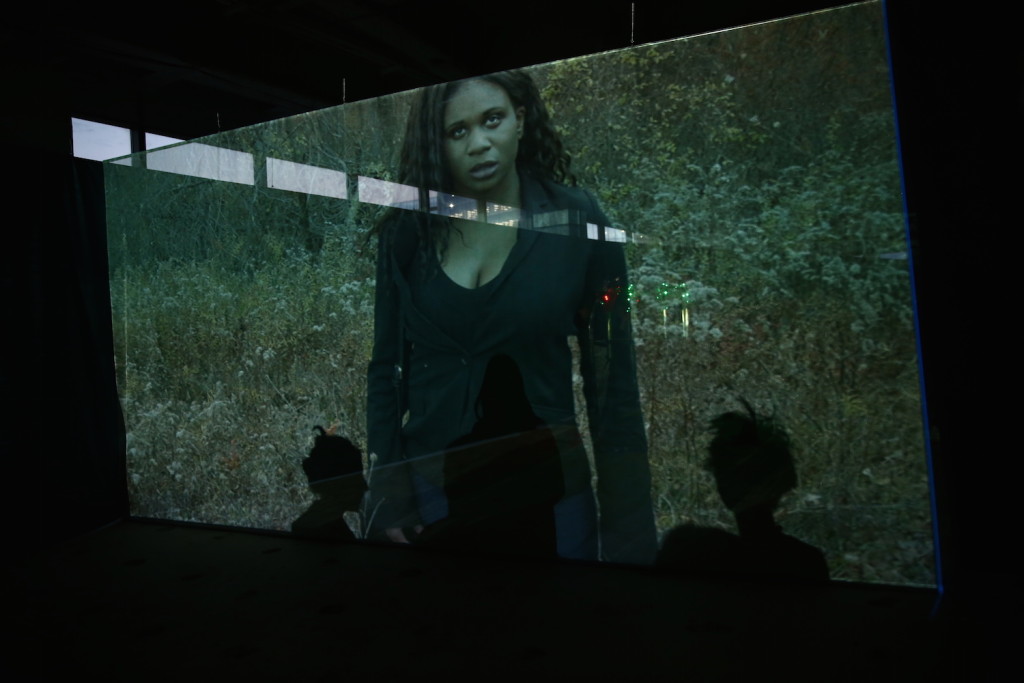
Jesper Just, “in the shadow/ of a spectacle/ is the view of the crowd” (2015) a commission of Performa 15. The performance was held at 225 Liberty Street, NY, Photograph by Paula Court, courtesy of Performa.
KDH: My instinct when first getting off the elevator was to move quickly through the crowd and see what was happening, if anything. Walking through them, I heard cellphones, ringing, beeping, and people using them to make phone calls, send texts. Initially, I was both amused and irritated because this is such a relevant sign of our society, yet I was a bit shocked that so many people hadn’t turned their ringers off. This is when I realized the ‘sounds’ (not only cellphones, but people dropping objects such as house keys, lighters) were part of the performance. Can you speak a bit on this. I thought it was fantastic and really effective.
Jesper Just: There were about 35 people infiltrating the audience as soon as everyone exited the elevator. They were given simple actions to create a particular rhythm, not as specific as a drumroll, but a random rhythm, something that seemed incidental, like dropping keys. They were also obstructing the staircase to the next level. Each segment was 15 minutes, and the role of the ‘Crowd’ was not acting, it was more about interaction with the way that the audience would move within the space. As the first 15 minutes end, members of the ‘Crowd’ start to move upstairs and it is at that moment that we hear another kind of sound. We were working with Crowds on Demand, where you can rent a crowd for your political rally or to be picked up from the airport. You can rent this group and they basically infiltrate the proposed area. It’s not about soft values it’s also in a way about trying to play with or rather reclaiming poetry. They were involved throughout the entire performance, standing as part of the audience but they also very subtly blocking doorways, contributing to the way the viewer moved through the space. They also appear in the first video, walking through a field appearing to look for something.
KDH: I liked how everyone just followed the members of the ‘Crowd’ as they went up the stairs. Crowd mentality really allows for this type of situation, posing the question and answer, “Where are they going? I want to follow.”
JJ: In the second movement, the music that the audience was presented with was actually made by a drone. It was this same drone that filmed the sequences being shown in the projected film. The flight pattern of the drone followed the flight of a musical composition. We used a metronome to produce the movement, counting for example ‘Forward, right, >makes clicking sound< back, left’. We imagined the musical composition and the image of the film was made, basically enslaved by the music. When a drone flies, it’s recording its own movements and flight data. So after the flight, we were able to tell it to do the same flight, and this is what was happening during the performance although it was in sync, yet bolted onto a metal structure with funnels and organ pipes. It was paralyzed in a way, onto the pipes of an organ so when the propellers spin, they blow the air into the tubes and creates the sound you heard during the performance. This was a collaboration with FOS who is a sculptor.
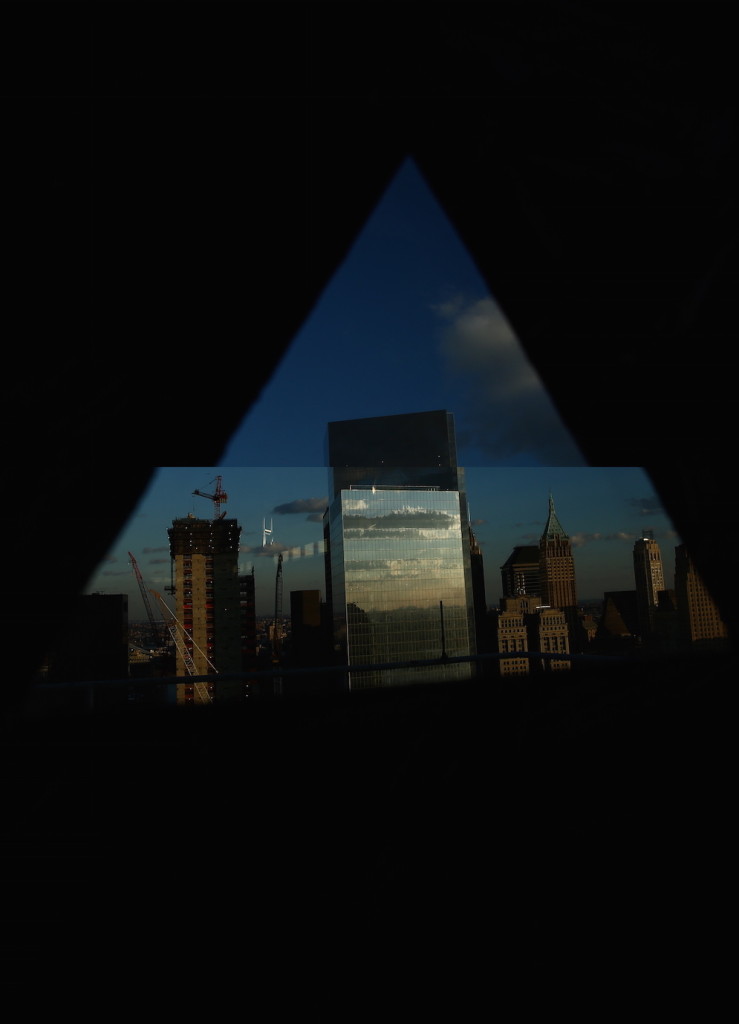
Jesper Just, “in the shadow/ of a spectacle/ is the view of the crowd” (2015) a commission of Performa 15. The performance was held at 225 Liberty Street, NY, Photograph by Paula Court, courtesy of Performa.
KHD: So basically as a viewer, there are several different levels of obstruction, by use of the crowd, fabric blocking the view limiting the feel of the space- even the objects themselves such as the drone, which was basically unrecognizable as such.
JJ: We were also focusing on the spectacle, hence the title ‘in the shadow/ of a spectacle/ is the view of the crowd‘, with the goal of removing the spectacle or orchestrating it, controlling it. A melodic sound that is being played via live transmission video is heard in the first movement and then seen in the third. A girl is sitting being filmed as the camera moves slowly, zooming closer and closer to a female bass player who was sitting in an office at W Magazine in One World Trade Center. For me, everything needs to make sense so I over research, and every action has a reason although not everyone will even have noticed. It’s very easy to make something strange, but if you make something where you don’t really know what’s going on but you feel you are still being lead, hand-held, but not given the words as to what is actually going on That is always the aim, not too literal, obvious or too symbolic but at the same time it shouldn’t just be ‘weird’. The first goal of this project was to make a visual symphony.
KDH: The main video in the first room on the second level, felt melancholic to me. Focusing on a crowd of people walking in an expansive field, they all had their heads down as if looking for something undetermined. It allowed me to feel intrigue but somehow also sadness.
JJ: I think it was the music that set a tone of melancholy. The music was in A minor, the drone organ was playing and it was an intentional move on my part. When people hear the word drone, there is a certain connotation that they associate with it, not necessarily nice. You can’t help but think about war, spies, and other things even if this type of drone in particular is not meant for that, I wanted to give the drone a kind of emotional pull, that the viewer could pick up on. This drone was built specifically for this project by a company in Industry City in California, normally providing drones for movies, to film a certain angle.
KDH: I like the concept of the aggregation of parts and the way that the project follows a systems although it’s a very conceptual, abstract system, something so subtle that it wouldn’t necessarily be perceived by the viewer. I like that this process adds to the substance of the performance. I allowed myself to be present in the space and be ‘taken’ if you will following the set pace. After speaking to a few other people who attended, I know this wasn’t the case and some people ran through at their own pace.
JJ: So much performance art today is just a show and literally can become theater. I’m not against theater but I would say that the force of performance is having the option to move around live elements, so it is like a living sculpture. But you are moving and you create the experience by the movement, not in a participatory way. It’s as if looking at a sculpture from a chair, which is not so interesting and may as well be flat. When you are in the cinema or watching something on the computer, you are paralyzed in a way. You don’t have your body in relation to what you are looking at. In my works, it’s important that the viewer is forced [or given the option] to move. For the last five years, I’ve made works that forces you to move in the space to experience them. These films look like movies, but they are not because there is no real narrative. One might ask themselves, “What is it I”m watching?” They expect something to happen and if it doesn’t, my hope is that they will start thinking about the concept of spectatorship.
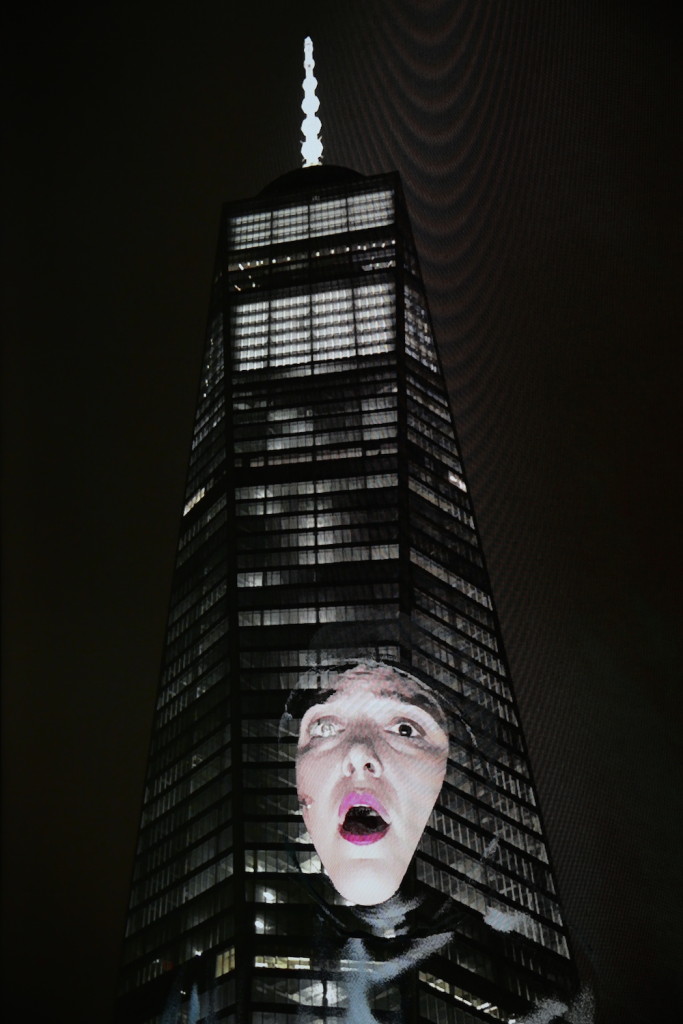
Jesper Just, “in the shadow/ of a spectacle/ is the view of the crowd” (2015) a commission of Performa 15. The performance was held at 225 Liberty Street, NY, Photograph by Paula Court, courtesy of Performa.
KDH: Can you talk a bit about the female presence in in the shadow/ of a spectacle/ is the view of the crowd?
JJ: There are three women who dominate the performance, one in the film (who has the most screen time), another playing the bass guitar and yet another who is singing in front of a green screen. The American muscle is so male, not in reference of the phallic symbol but [the gesture of] reclaiming the elements of: finance, steel and glass. The financial district is all about power, so we used female musicians purposefully, giving them the control through the musicality, composition, and purpose of presence. In the last room, a woman can be heard singing and there is a narrow monitor with a floating face on it, singing in front of the building, almost as if she is in a duet with the bass player, even though they are in different locations. It’s as if the tower itself is making music; through the girl playing bass inside and a floating head outside. It folds into itself becoming a funnel-obscuring the view, becoming the view and then offering a view of the final singer, live, dressed in the same green fabric that is covering the walls and the windows. At this point, when the viewer reaches the woman singing in front of the green screen, it is the beginning of the final section, the fourth movement, where everything comes together.
KDH: What else can you say about the final singer who is both physically present and projected simultaneously?
JJ: When we came up with that idea we thought it would be light or lighten up the mood, but I don’t think it worked in that way. Giving the building a voice didn’t end up being light but actually carried additional weight. Having the attacks in Paris, happen the night of the first performance really put a shadow over everything and it was very strange to experience that suddenly. For me this had nothing to do with a memorial, but I think it was read like that by a lot of people. That is fine because if you want to control something you have to be more direct in saying it is not about this, or just not be in this particular area I suppose.
KDH: I didn’t go into this project thinking of it as a memorial, I just think that as a viewer you can’t help but associate or carry a particular feeling related to where you happen to be. What initially triggered your interest in this building, this particular area? It is obviously very loaded.
JJ: I always start my projects first with a place. I was invited for a show at the Palais de Tokyo, and when investigating where I wanted to exhibit, I was drawn to the basement, the last place most invited artists want to show. I took the two lowest levels. It’s a very complex space because some parts are really high and others are very low and dark because there aren’t any windows. I started to think of this architecture as the human body and architecture and how if there is an error, they can be rejected. In a similar way, when someone is physically challenged, they can be looked at as if they have a defect of some sort. I thought about ableism and the concept of One World Trade as a character, a phantom limb. Sometimes it is a mediator, sometimes it is a container of sound, either way it’s functioning as a way to bring people together.
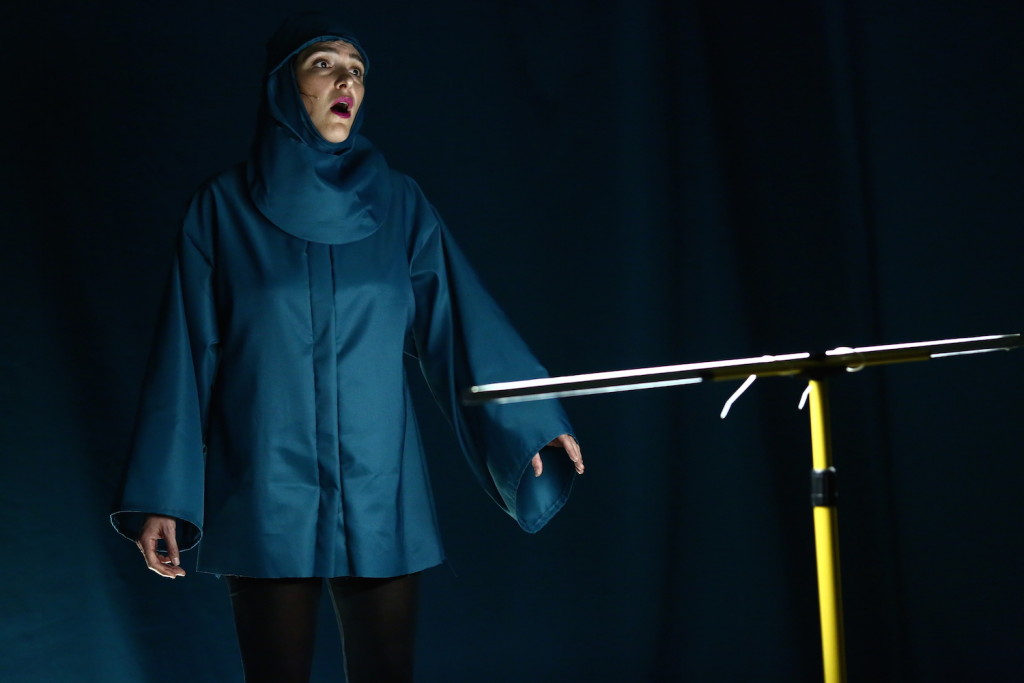
Jesper Just, “in the shadow/ of a spectacle/ is the view of the crowd” (2015) a commission of Performa 15. The performance was held at 225 Liberty Street, NY, Photograph courtesy of Performa.
